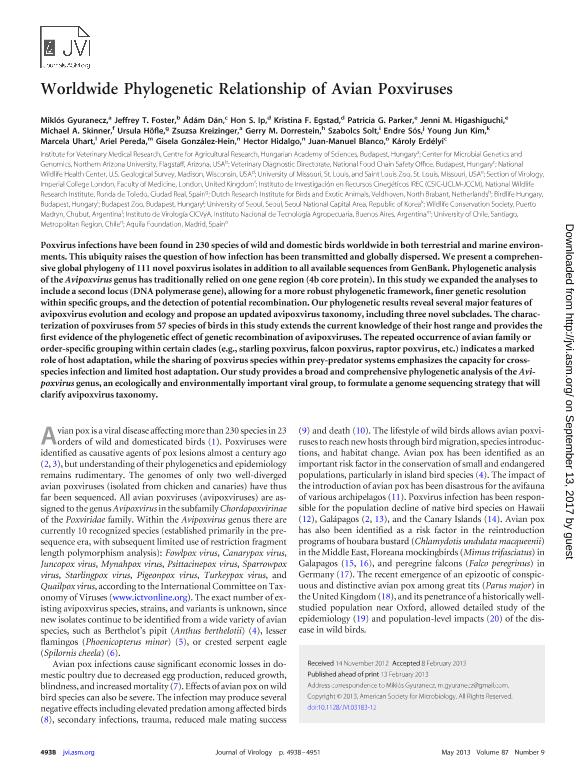Mostrar el registro sencillo del ítem
dc.contributor.author
Gyuranecz, Miklós
dc.contributor.author
Foster, Jeffrey T.
dc.contributor.author
Dán, Ádam
dc.contributor.author
Ip, Hon S.
dc.contributor.author
Egstad, Kristina F.
dc.contributor.author
Parker, Patricia G.
dc.contributor.author
Higashiguchi, Jenni M.
dc.contributor.author
Skinner, Michael A.
dc.contributor.author
Höfle, Ursula
dc.contributor.author
Kreizinger, Zsuzsa
dc.contributor.author
Dorrestein, Gerry M.
dc.contributor.author
Solt, Szalbolcs
dc.contributor.author
Sós, Endre
dc.contributor.author
Kim, Young Jun
dc.contributor.author
Uhart, Marcela María

dc.contributor.author
Pereda, Ariel Julián

dc.contributor.author
González Hein, Gisela
dc.contributor.author
Hidalgo, Hector
dc.contributor.author
Blanco, Juan Manuel
dc.contributor.author
Erdélyi, Károly
dc.date.available
2017-09-13T15:18:27Z
dc.date.issued
2013-05
dc.identifier.citation
Gyuranecz, Miklós; Foster, Jeffrey T.; Dán, Ádam; Ip, Hon S.; Egstad, Kristina F.; et al.; Worldwide phylogenetic relationship of avian poxviruses; American Society for Microbiology; Journal of Virology; 87; 9; 5-2013; 4938-4951
dc.identifier.issn
0022-538X
dc.identifier.uri
http://hdl.handle.net/11336/24128
dc.description.abstract
Poxvirus infections have been found in 230 species of wild and domestic birds worldwide in both terrestrial and marine environments. This ubiquity raises the question of how infection has been transmitted and globally dispersed. We present a comprehensive global phylogeny of 111 novel poxvirus isolates in addition to all available sequences from GenBank. Phylogenetic analysis of the Avipoxvirus genus has traditionally relied on one gene region (4b core protein). In this study we expanded the analyses to include a second locus (DNA polymerase gene), allowing for a more robust phylogenetic framework, finer genetic resolution within specific groups, and the detection of potential recombination. Our phylogenetic results reveal several major features of avipoxvirus evolution and ecology and propose an updated avipoxvirus taxonomy, including three novel subclades. The characterization of poxviruses from 57 species of birds in this study extends the current knowledge of their host range and provides the first evidence of the phylogenetic effect of genetic recombination of avipoxviruses. The repeated occurrence of avian family or order-specific grouping within certain clades (e.g., starling poxvirus, falcon poxvirus, raptor poxvirus, etc.) indicates a marked role of host adaptation, while the sharing of poxvirus species within prey-predator systems emphasizes the capacity for cross-species infection and limited host adaptation. Our study provides a broad and comprehensive phylogenetic analysis of the Avipoxvirus genus, an ecologically and environmentally important viral group, to formulate a genome sequencing strategy that will clarify avipoxvirus taxonomy.
dc.format
application/pdf
dc.language.iso
eng
dc.publisher
American Society for Microbiology

dc.rights
info:eu-repo/semantics/openAccess
dc.rights.uri
https://creativecommons.org/licenses/by/2.5/ar/
dc.subject
Poxviruses
dc.subject
Avian
dc.subject
Phylogeny
dc.subject
Worldwide
dc.title
Worldwide phylogenetic relationship of avian poxviruses
dc.type
info:eu-repo/semantics/article
dc.type
info:ar-repo/semantics/artículo
dc.type
info:eu-repo/semantics/publishedVersion
dc.date.updated
2017-09-12T16:30:32Z
dc.journal.volume
87
dc.journal.number
9
dc.journal.pagination
4938-4951
dc.journal.pais
Estados Unidos

dc.journal.ciudad
Washington D. C.
dc.description.fil
Fil: Gyuranecz, Miklós. Hungarian Academy of Sciences; Hungría
dc.description.fil
Fil: Foster, Jeffrey T.. University of Arizona; Estados Unidos
dc.description.fil
Fil: Dán, Ádam. National Food Chain Safety Office; Hungría
dc.description.fil
Fil: Ip, Hon S.. United States Geological Survey; Estados Unidos
dc.description.fil
Fil: Egstad, Kristina F.. United States Geological Survey; Estados Unidos
dc.description.fil
Fil: Parker, Patricia G.. University of Missouri; Estados Unidos
dc.description.fil
Fil: Higashiguchi, Jenni M.. University of Missouri; Estados Unidos
dc.description.fil
Fil: Skinner, Michael A.. Imperial College London; Reino Unido
dc.description.fil
Fil: Höfle, Ursula. Consejo Superior de Investigaciones Cientificas; España. Universidad de Castilla-La Mancha. Instituto de Investigación en Recursos Cinegéticos; España
dc.description.fil
Fil: Kreizinger, Zsuzsa. Hungarian Academy of Sciences; Hungría
dc.description.fil
Fil: Dorrestein, Gerry M.. Dutch Research Institute for Birds and Exotic Animals; Países Bajos
dc.description.fil
Fil: Solt, Szalbolcs. Birdlife Hungary; Hungría
dc.description.fil
Fil: Sós, Endre. Budapest Zoo; Hungría
dc.description.fil
Fil: Kim, Young Jun. University of Seoul; Corea del Sur
dc.description.fil
Fil: Uhart, Marcela María. Wildlife Conservation Society; Estados Unidos
dc.description.fil
Fil: Pereda, Ariel Julián. Instituto Nacional de Tecnología Agropecuaria. Centro de Investigación en Ciencias Veterinarias y Agronómicas. Instituto de Virología; Argentina. Consejo Nacional de Investigaciones Científicas y Técnicas; Argentina
dc.description.fil
Fil: González Hein, Gisela. Universidad de Chile; Chile
dc.description.fil
Fil: Hidalgo, Hector. Universidad de Chile; Chile
dc.description.fil
Fil: Blanco, Juan Manuel. Aquila Foundation; España
dc.description.fil
Fil: Erdélyi, Károly. National Food Chain Safety Office; Hungría
dc.journal.title
Journal of Virology

dc.relation.alternativeid
info:eu-repo/semantics/altIdentifier/doi/http://dx.doi.org/10.1128/JVI.03183-12
dc.relation.alternativeid
info:eu-repo/semantics/altIdentifier/url/https://www.ncbi.nlm.nih.gov/pmc/articles/PMC3624294/
dc.relation.alternativeid
info:eu-repo/semantics/altIdentifier/url/http://jvi.asm.org/content/87/9/4938.long
Archivos asociados
